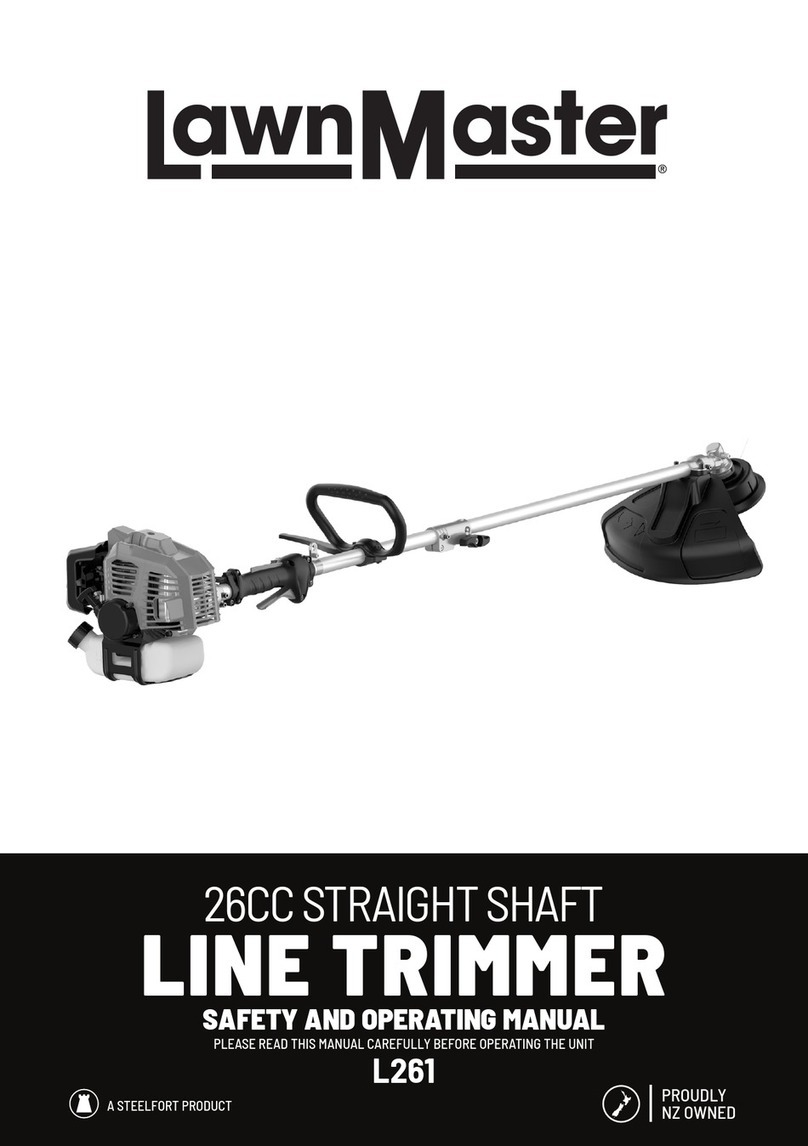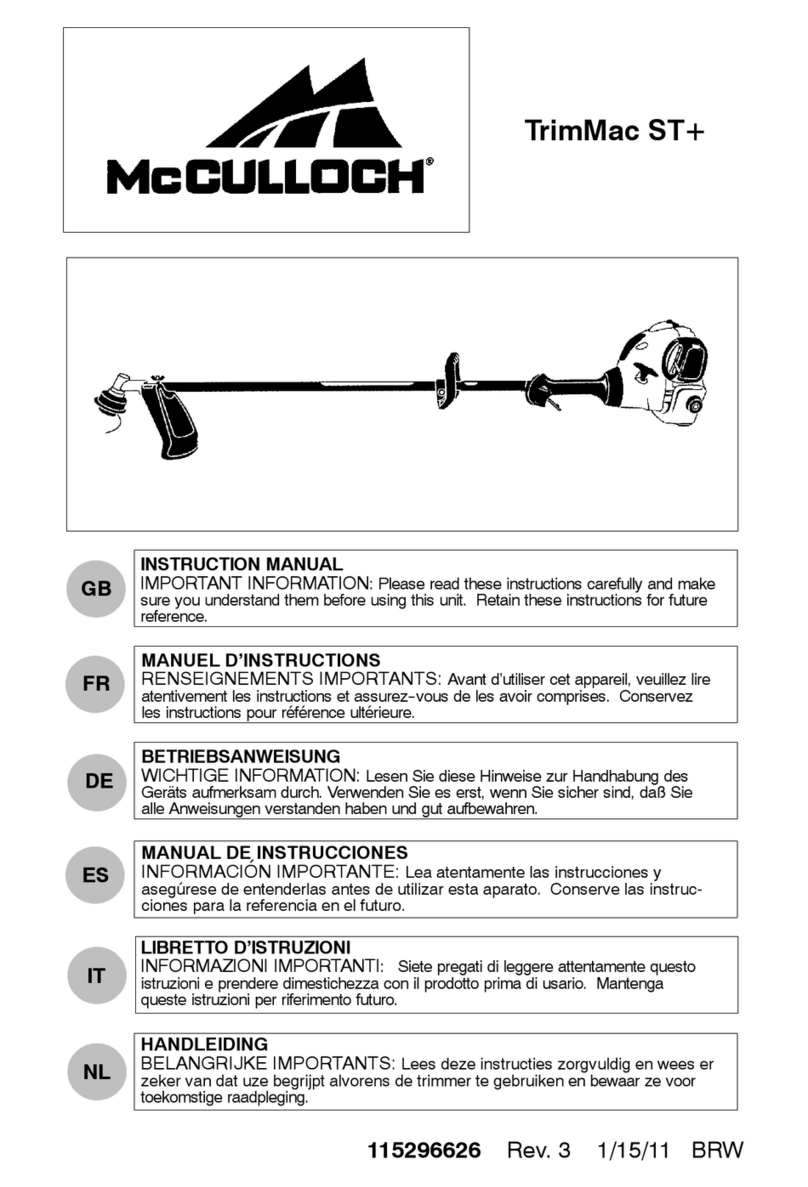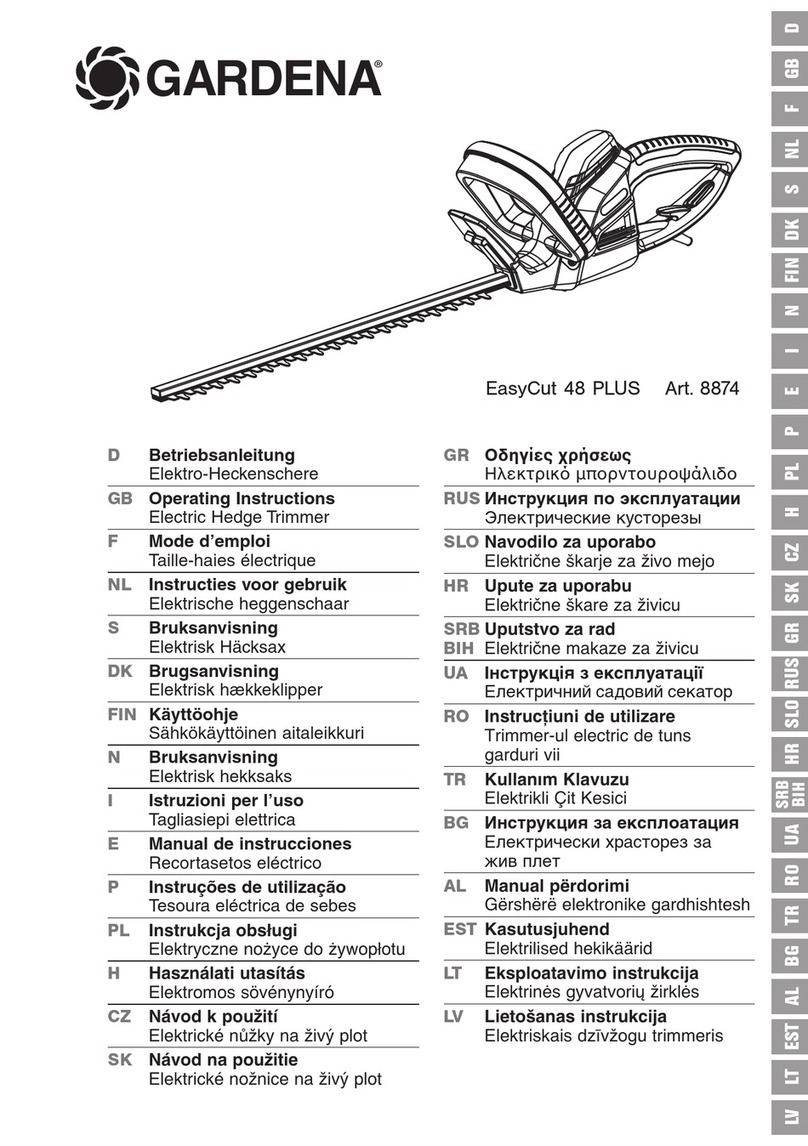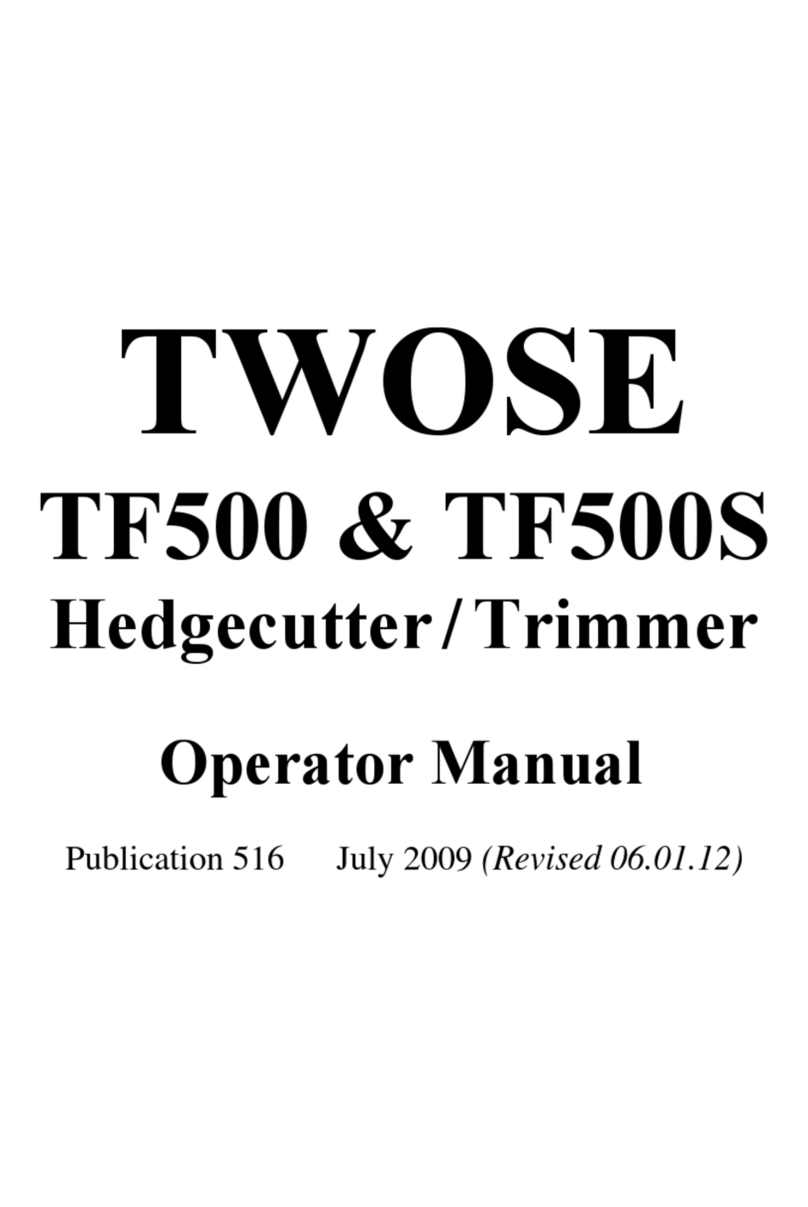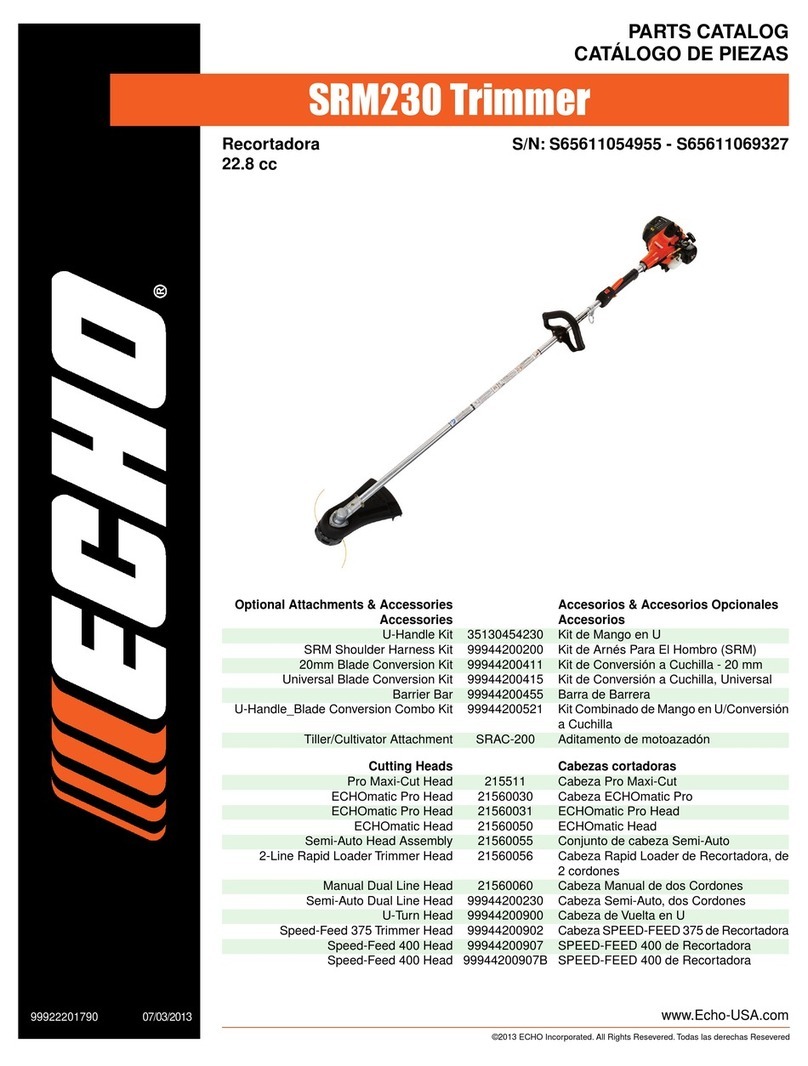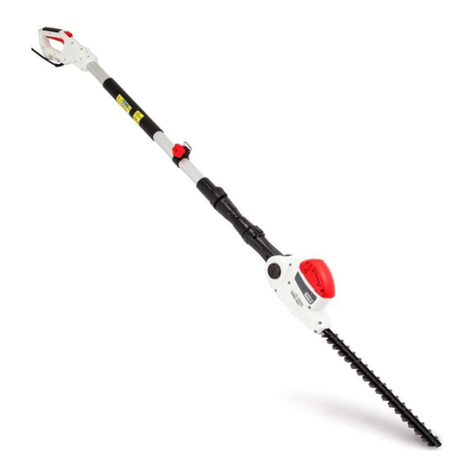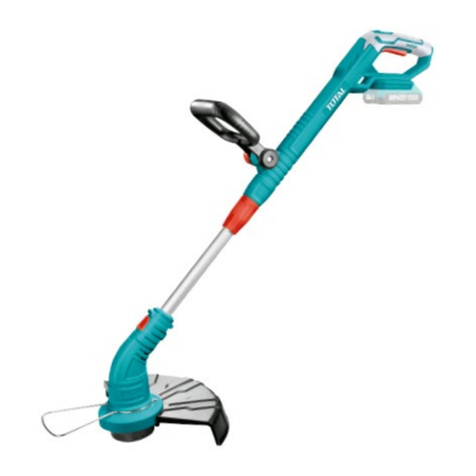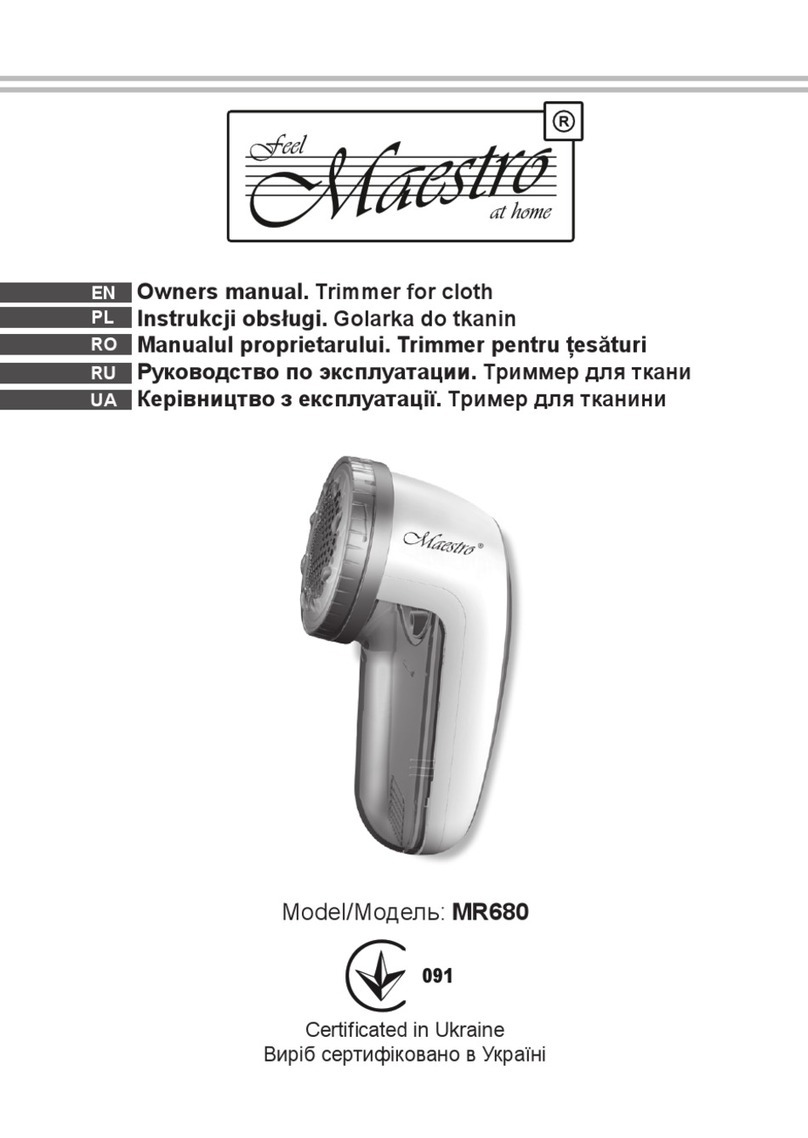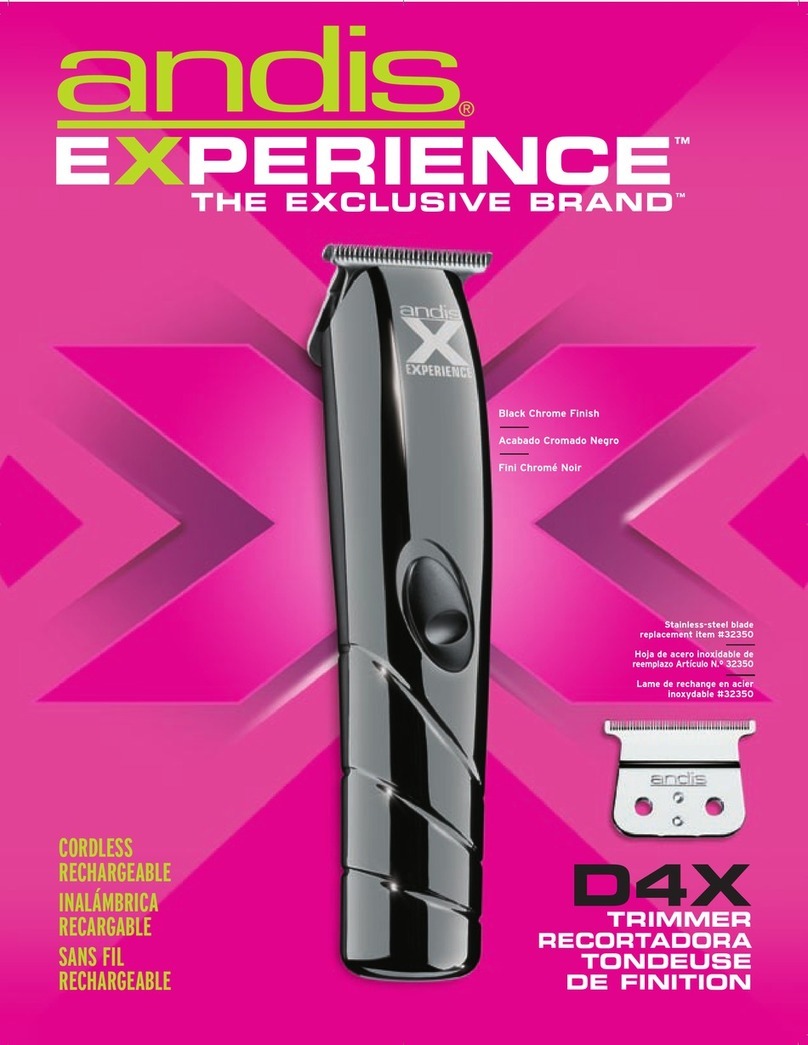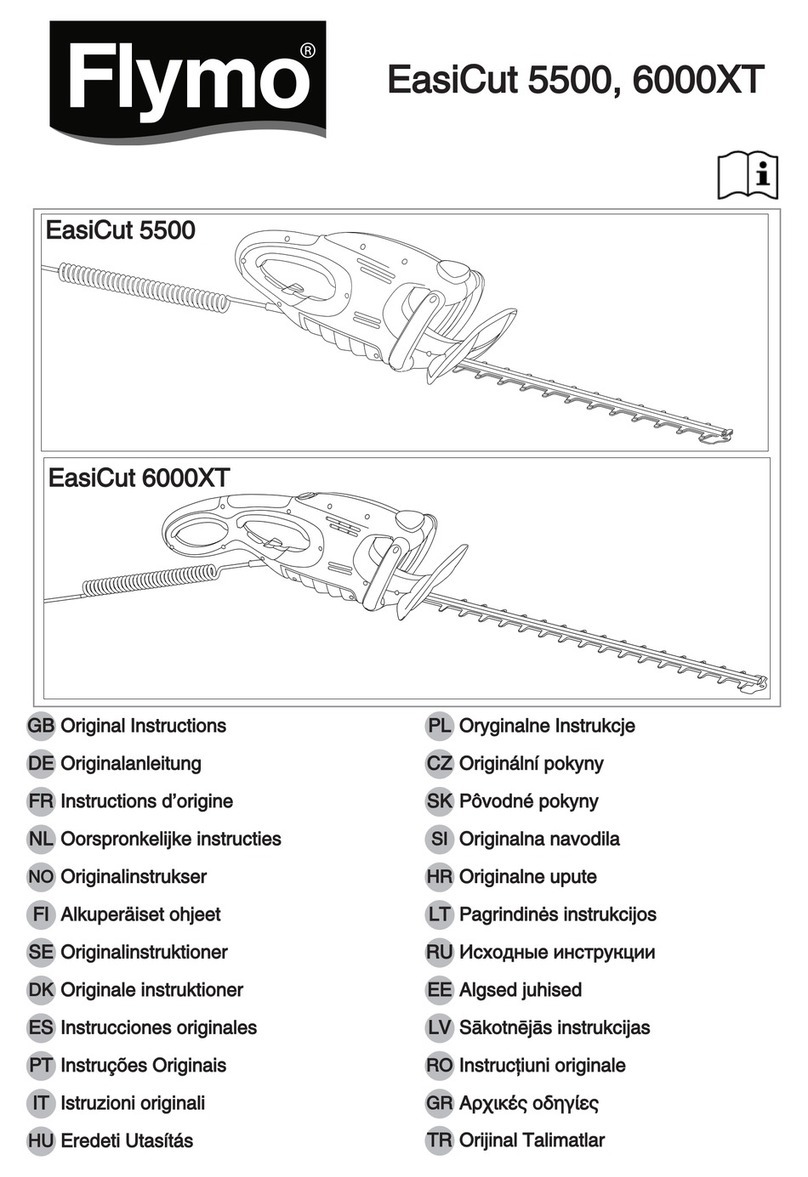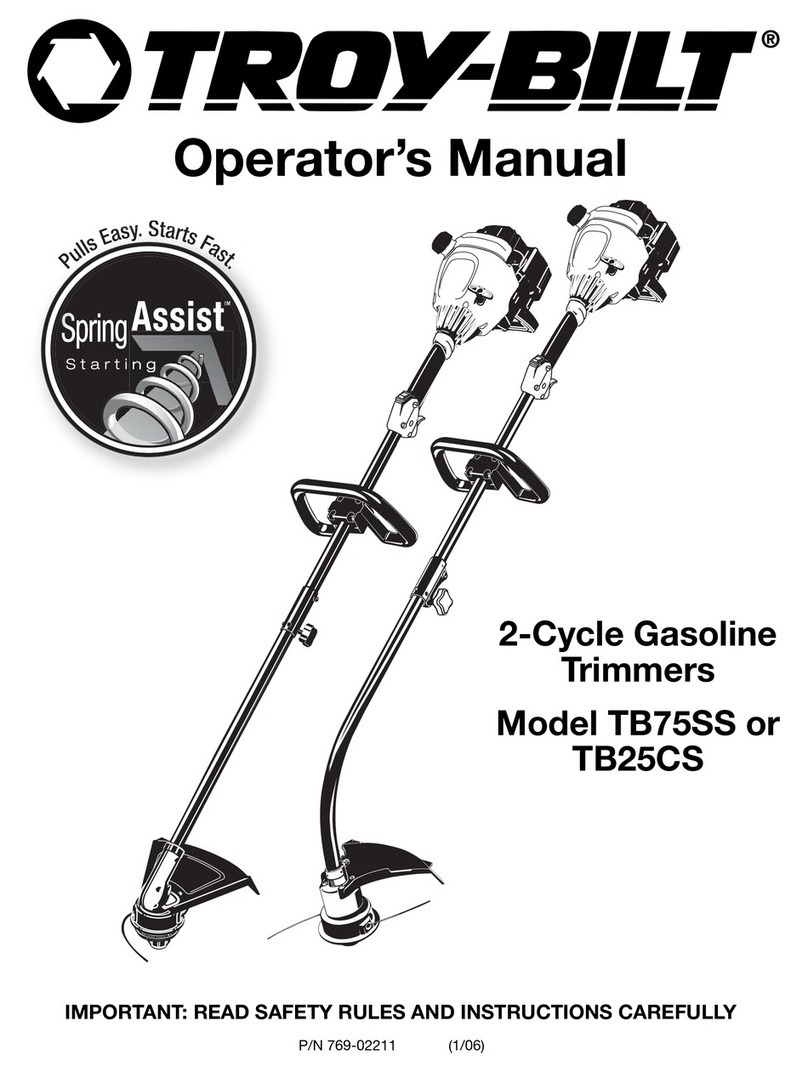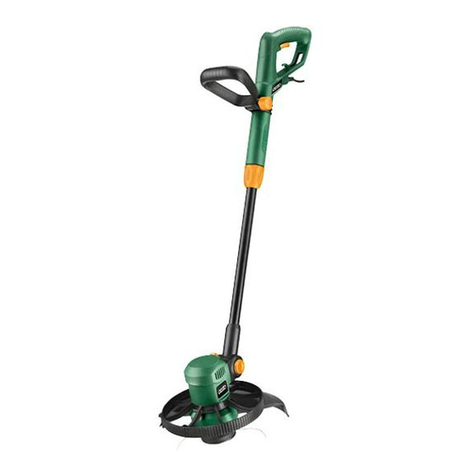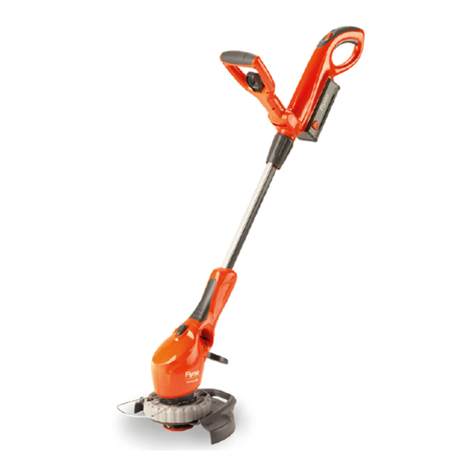Shundaiwa LE260 Owner's manual

ENGLISH
SHINDAIWA OWNER’S/OPERATOR’S MANUAL
T260 GRASS TRIMMER
T260X GRASS TRIMMER
LE260 LAWN EDGER
C260 BRUSHCUTTER
Part Number 62710-94310 Rev. 8/05
Minimize the risk of injury to yourself and others!
Read this manual and familiarize yourself with the
contents. Always wear eye and hearing protection
when operating this unit.
WARNING!
C260
T260
LE260
T260X

2
WARNING!
Use Good Judgment
NEVER operate the engine when trans-
porting the unit.
NEVER operate the engine indoors!
Make sure there is always good ventila-
tion. Fumes from engine exhaust can
cause serious injury or death.
ALWAYS use the proper cutting tool for
the job.
ALWAYS stop the unit immediately if
it suddenly begins to vibrate or shake.
Inspect for broken, missing or improp-
erly installed parts or attachments.
NEVER extend trimming line beyond
the length specified for your unit.
ALWAYS keep the unit as clean as
practical. Keep it free of loose vegeta-
tion, mud, etc.
ALWAYS hold the unit firmly with both
hands when cutting or trimming, and
maintain control at all times.
ALWAYS keep the handles clean.
ALWAYS disconnect the spark plug
wire before performing any
maintenance work.
ALWAYS if a blade should bind fast in
a cut, shut off the engine immediately.
Push the branch or tree to ease the bind
and free the blade.
Introduction
Attention Statements .................................. 2
Safety Information ....................................... 2
Safety Labels ................................................ 4
Product Description .................................... 6
Specifications ............................................... 6
Assembly ...................................................... 7
Installing Cutting Attachments ................ 11
Engine Fuel ............................................... 15
Starting the Engine ................................... 16
Stopping The Engine ................................ 16
Adjusting Engine Idle ............................... 17
Checking Unit Condition ......................... 17
Shoulder Strap ........................................... 17
Cutting Grass (trimmer head) ................ 18
Using a Brushcutter Blade ...................... 19
Using the Edger ........................................ 20
Maintenance .............................................. 21
Muffler Service ......................................... 23
Long Term Storage ................................... 24
Blade Sharpening ...................................... 24
Troubleshooting Guide ............................ 25
Emission System Warranty ...................... 26
PAGE
The Shindaiwa 260-series hand held power
equipment has been designed and built to
deliver superior performance and reliability
without compromise to quality, comfort,
safety, or durability.
Shindaiwa’s high-performance engines rep-
resent the leading edge of 2-cycle engine
technology, delivering exceptionally high
power with remarkably low displacement
and weight. As an owner/operator, you’ll
soon discover for yourself why Shindaiwa is
simply in a class by itself!
IMPORTANT!
The information contained in this manual
describes units available at the time of
publication.
Shindaiwa Inc. reserves the right to make
changes to products without prior notice,
and without obligation, to make alterations
to units previously manufactured.
Contents
WARNING!
The engine exhaust from this product
contains chemicals known to the State
of California to cause cancer, birth de-
fects or other reproductive harm.
Throughout this manual are special
“Attention Statements”.
IMPORTANT!
The operational procedures described in
this manual are intended to help you get
the most from your unit, and to protect you
and others from harm. These procedures
are guidelines for safe operation under most
conditions, and are not intended to replace
any safety rules and/or laws that may be in
force in your area.
If you have questions regarding your 260-
series unit, or if you do not understand
something in this manual, your Shindaiwa
dealer will be glad to assist you.
You may also contact Shindaiwa, Inc. at the
address printed on the back of this Manual.
Attention Statements
CAUTION!
A statement preceded by the word
“CAUTION” contains information that
should be acted upon to avoid damag-
ing the unit.
IMPORTANT!
A statement preceded by the word
“IMPORTANT” is one that possesses
special significance.
NOTE:
A statement preceded by the word “NOTE”
contains information that is handy to know
and may make your job easier.
WARNING!
A statement preceded by the trian-
gular attention symbol and the word
“WARNING” contains information that
should be acted upon to prevent seri-
ous bodily injury.
Read and follow this�
operators manual.�
Failure to do so could�
result in serious injury.
�
Wear eye and hearing�
protection at all times�
during the operation �
of this unit.
Keep bystanders�
at least 50 feet (15 m)�
away during operation.
Beware of thrown or �
ricocheted objects.
Do not operate this unit�
with a blade unless the�
unit is equipped with a�
handlebar.
Always wear a harness�
when operating this unit�
with a blade. A harness�
is also recommended when �
using trimmer line.�
�
If unit is used as a �
brushcutter, beware of�
blade thrust. A jammed�
blade can cause the unit�
to jerk suddenly and may�
cause the operator to�
lose control of the unit.�
�
�
Work Safely
Trimmers and brushcutter operate at very
high speeds and can do serious damage or
injury if they are misused or abused. Never
allow a person without training or instruc-
tion to operate this unit!
General Safety Instructions
WARNING!
Never make unauthorized attachment
installations.

3
The Properly Equipped Operator
Stay Alert
You must be physically and mentally fit to
operate this unit safely.
WARNING!
Never operate power equipment of any
kind if you are tired or if you are under
the influence of alcohol, drugs, medica-
tion or any other substance that could
affect your ability or judgement.
WARNING!
Minimize the Risk of Fire
NEVER smoke or light fires near the
unit.
ALWAYS stop the engine and allow it
to cool before refueling. Avoid overfill-
ing and wipe off any fuel that may have
spilled.
ALWAYS inspect the unit for fuel leaks
before each use. During each refill,
check that no fuel leaks from around the
fuel cap and/or fuel tank. If fuel leaks
are evident, stop using the unit immedi-
ately. Fuel leaks must be repaired before
using the unit.
ALWAYS move the unit to a place well
away from a fuel storage area or other
readily flammable materials before start-
ing the engine.
NEVER place flammable material close
to the engine muffler.
NEVER run the engine without the
spark arrester screen in place.
General Safety Instructions
Always wear a harness when
operating a unit equipped
with a blade.
Wear appropriate footwear
(non-skid boots or shoes): do not wear
open-toed shoes or sandals. Never work
barefooted!
Wear hearing protection devices and a
broad-brimmed hat or helmet.
Wear close-fitting clothing to
protect legs and arms. Gloves
offer added protection and
are strongly recommended.
Do not wear clothing or
jewelry that could get caught
in machinery
or underbrush.
NEVER wear
shorts!
Always wear eye
protection such as goggles or
safety glasses.
Always operate with both
hands firmly gripping the
unit.
When operating with a blade, make
sure the handle is positioned to
provide you with maximum protec-
tion from contacting the blade.
Keep away from the rotating
trimming line or blade at all
times, and never lift a moving
attachment above waist-high.
Keep a proper
footing and do not
overreach—
maintain your balance
at all times during
operation.
Always make sure the
appropriate cutting
attachment shield is
correctly installed.
Figure 1

4
Safety Labels
Figure 2
IMPORTANT!
Safety and Operation Information Labels:
Make sure all information labels are
undamaged and readable. Immediately
replace damaged or missing information
labels. New labels are available from your
local authorized Shindaiwa dealer.
Read Operator's Manual
Protect
eyes
and
hearing
Keep
bystanders
at least
50 ft.
away
Use handlebar when
operating with a blade
Wear harness when
operating with a blade
Beware of
blade thrust
Do not operate under
influence of alcohol,
drugs or medication
61843
T260
LE260
This label indicates the minimum
distance between front handle and
rear grip per ANSI B175.3.
T260X
C260

5
Be Aware of the Working Environment (all units)
Avoid long-term operation
in very hot or very cold
weather. Make sure bystanders or observers outside the
50-foot “danger zone” wear eye protection.
Be extremely
careful of
slippery terrain,
especially during
rainy weather.
Beware of a coasting blade. A coasting
blade can injure while it continues to
spin after the throttle trigger is released
or after the engine is stopped.
When operating in rocky terrain or near electric
wires or fences, use extreme caution to avoid
contacting such items with the cutting attachment.
Be constantly alert for objects and debris that could be
thrown either from the rotating cutting attachment or
bounced from a hard surface.
If contact is made with
a hard object, stop the
engine and inspect the
cutting attachment for
damage.
Reduce the risk of
bystanders being struck
by flying debris. Make
sure no one is within 50
feet (15 meters)—that’s
about 16 paces—of an
operating attachment.
Figure 3
50
FEET
Always make sure the
appropriate cutting
attachment shield is
correctly installed.

6
WARNING!
Do not make unauthorized modifica-
tions or alterations to any of these units
or their components.
Product Description
T260/T260X GRASS TRIMMER
Using the accompanying illustrations as a
guide, familiarize yourself with your unit
and its components. Understanding your
unit helps ensure top performance, long
service life, and safer operation.
Grip
Throttle Trigger
Handle
Outer Tube
C260 BRUSHCUTTER
Brushcutter Blade
Outer Tube
Handlebar
Cylinder
Cover
Gearcase
Gearcase
Throttle
Trigger
Edger
Blade Depth
Adjustment
Outer Tube
Handle Grip
Cutting
Attachment
Shield
Line Cutter (T260/T260X)
Tank Protector
Tank Protector
LE260 LAWN EDGER
Cutting
Attachment Shield
Cutting
Attachment
Shield
Figure 4
Spark Plug
Fuel
Tank
Spark Plug
Fuel
Tank
Spark Plug
Fuel
Tank
Tank Protector
Ignition
Switch
Ignition
Switch
Ignition
Switch
Specifications
T260/T260X Dry Weight (less attachments) ............ 5.0 kg/11.0 lb.
LE260 Dry Weight (less attachments) .....................5.6 kg/12.3 lb.
C260 Dry Weight (less attachments) .........................5.2 kg/11.5 lb.
Engine Model .............................................................Shindaiwa S260
Engine Type ..............................2-cycle, vertical-cylinder, air-cooled
Bore x Stroke ........................................... 32 x 30 mm/1.26 x 1.18 in.
Displacement .......................................................... 24.1 cc/1.5 cu. in.
Maximum Power Output ..........1.2 hp/0.9 kW @ 7500 RPM (min-1)
Fuel/Oil Ratio ..................... 50:1 with Shindaiwa 2-cycle Mixing Oil
Fuel Tank Capacity .....................................................600 cc/20.3 oz.
Carburetor Type ........................................TK-DPN, diaphragm-type
Ignition ................................... Fully electronic, transistor-controlled
Spark Plug .................................................................. Champion CJ8Y
(for EMC compliance use NGK BMR6A)
Air Filter ..................................Non-reversible flocked filter element
Starting Method ......................................................................... Recoil
Stopping Method .............................................................. Slide switch
Transmission Type ............................. Automatic, centrifugal-clutch
w/bevel gear
EPA Emission Compliance Period* ................................ Category A
* The EPA emission compliance referred to on the emission compliance label
located on the engine, indicates the number of operating hours for which the
engine has been shown to meet Federal emission requirements. Category
C = 50 hours (Moderate), B = 125 hours (Intermediate) and A = 300 hours
(Extended).
Specifications are subject to change without notice.
Prior to Assembly
Before assembling, make sure you have all
the components required for a complete
unit:
Engine assembly
Outer tube assembly
Cutting attachment shield
Cutting attachment
(trimmer head or brushcutter blade)
Correct operator’s handle
(see pages 7-9)
Kit containing debris shield mounting
bracket and hardware, operator’s handle
mounting bracket and hardware, this
manual and tool kit for routine main-
tenance. Tool kits vary by model and
may include a hex wrench, spark-plug/
screwdriver combination wrench, and
spanner.
Carefully inspect all components
for damage.
IMPORTANT:
The terms “left,” “left-hand,” and “LH”:
“right,” “right-hand,” and “RH”; “front” and
“rear” refer to directions as viewed by the
operator during normal operation of this
product.
Barrier
260X Only

7
Assembly: Driveshaft/Powerhead All Models
1. Place the powerhead on a clean, flat
surface, spark plug facing up.
2. Use the 4 mm
hex wrench to
loosen the tube
clamp screw.
3. Slide the outer
tube into the
tube clamp until
the tube bot-
toms. If installa-
tion is difficult,
rotate the outer
Tube Clamp
Hex Wrench
tube or gearcase output shaft slightly un-
til you feel the mainshaft splines engage
with the powerhead.
4. Position the outer tube so that the
gearcase output shaft is facing down
(opposite the spark plug).
T260/T260X/LE260 — Slide the
outer tube into the powerhead until
the throttle grip just contacts the tube
clamp.
Connect the Outer Tube
to the Powerhead.
CAUTION!
Do not force the outer tube into the
powerhead! Excessive force can
damage the outer tube and mainshaft.
Clamp must fit next to line on
outer-tube decal
T260/T260X
LE260
Powerhead
Outer
Tube
Decal
C260 Brushcutter
Mainshaft
Clamp Screw
Throttle Assembly
Tube Clamp
Clamp
Figure 6
Figure 5
Spark Plug
C260 — Slide the outer tube into the
powerhead until the installation decal
aligns with the tube clamp.
5. Tighten the clamp screw firmly.
Assembly: Handle T260
Handle
Socket-head
Cap Screw
Outer Tube
Trigger Housing
Figure 7
Handle Positioning Label
Connect the Handle
to the Outer Tube.
1. Position the handle on the outer tube
forward of Handle Positioning Label as
shown in Figure 7.
2. Install the mounting bracket with the
socket head cap screws. Tighten the
screws finger-tight ONLY at this time.
3. Locate the handle in the best position
for operator comfort (usually about 10
inches ahead of the throttle housing).
4. Secure the handle by alternately tighten-
ing the four socket-head screws in a
diagonal or “crisscross” fashion.
Mounting Bracket

8
Barrier Bar and Hanger Assembly
Connect the Handle
to the Outer Tube.
1. Remove the four socket-head cap screws
on the handle and remove the handle
and mounting bracket.
2. Position the handle on the outer tube
forward of Handle Positioning Label as
shown in Figure 8.
3. Install the barrier bar with the socket-
head cap screws and nuts. Tighten the
screws finger-tight ONLY at this time.
4. Locate the handle in the best position
for operator comfort (usually about 10
inches ahead of the throttle housing).
5. Secure the handle by alternately tighten-
ing the four socket-head screws in a
diagonal or “criss-cross” fashion.
6. Position the hanger on the outer tube
between the handle and throttle assem-
bly. See Figure 8.
7. Secure the hanger with the nut and bolt
as shown in Figure 8.
Outer Tube
Socket-head
Caps Screws
Handle
Barrier Bar
Throttle
Assembly
Figure 8
Handle Positioning Label
Bolt
Nut
Hanger
Nuts
Assembly: Handle LE260
1. Remove both screws from the handle.
2. While spreading the handle at the
mounting hole, position the handle on
the outer tube as shown.
3. Reinstall the two mounting screws in the
handle, but do not tighten them at this
time.
NOTE:
The handle is recessed to receive the hex
nuts.
4. Locate the handle at the best position
for operator comfort (usually about 10
inches ahead of the throttle lever).
5. Secure the handle by tightening the
knob at the handle base.
Handle
Hex Nut
Washer
Hex Nut
Outer Tube
Adjustment
Knob
Mounting Screw
Trigger Assembly
Washer
Connect the Handle
to the Outer Tube.
Figure 9
26049

9
Assembly: Throttle Linkage and Ignition Leads
T260/T260X/LE260
26005
Throttle Cable
Install the Throttle Cable (T260/
T260X/LE260)
1. Loosen and remove the throttle lever
clamp screw “A”.
2. Extend the throttle lever.
3. Starting from the powerhead, push the
throttle cable through the handgrip until
it appears at the throttle assembly.
4. Insert the throttle cable end into the
socket on the throttle lever.
5. Retract the throttle lever to its original
position.
6. Replace and tighten the throttle lever
clamp screw “A”.
7. Using finger pressure only, connect the
red and black ignition wires onto the
connectors on the powerhead (see the
inset).
Insert throttle
end into the
socket
Clamp
Screw “A”
Extended
Throttle
Lever
Red Ignition
Wire
Black Igni-
tion Wire
Connector
Connector
Figure 11
Nut
Throttle
Cable
Assembly: Handle C260
Assemble the Handlebar
1. Position the handle over the outer tube
forward of Handle Positioning Label as
shown in Figure 10. The handlegrips
must face “up,” with the throttle lever
to the right-hand side as shown in
Figure 10.
2. Attach the handle mounting bracket
from below using the two socket-head
cap screws, washers, and lock washers.
Tighten both screws FINGER TIGHT
ONLY at this time.
3. Locate the handle in the best position for
operator comfort (usually about 5 inches
ahead of the harness loop.) If necessary,
reposition the aluminum collar between
the handlebar bracket and outer tube.
IMPORTANT!
The aluminum collar must be installed
between the handlebar bracket and outer
tube! If the aluminum collar is omitted or is
improperly installed, the handlebar bracket
cannot be properly secured.
4. Use the hex wrench to securely tighten
both handlebar cap screws.
5. Working from the handlebar toward the
powerhead, route the ribbed throttle
cable tube through the two rubber
mounts on the outer tube.
Outer Tube
Handlebar
Rubber Mount
Rubber Mount
Socket-head
Cap Screw Mounting Bracket
Cable Tube
Figure 10
Handle Positioning Label

10
1. Loosen and remove the throttle lever
clamp screw “A”, and slide the throttle
assembly about 1-inch away from the
handgrip.
2. Extend the throttle lever (inset).
3. Push the throttle cable and switch wires
through the handgrip until it appears at
the throttle assembly.
4. Insert the throttle cable end into the
socket on the throttle lever.
5. Retract the throttle lever to its original
position.
6. Using finger pressure only, gently push
the red and black ignition wires onto
the connectors underneath the throttle
assembly
7. Slide the throttle assembly back to its
original position, and then replace and
tighten the throttle lever clamp screw
“A”.
Install the Throttle Cable (C260)
Assembly: Throttle Linkage and Ignition Leads C260
Insert ignition wires
onto connectors (not
color coded)
Handlebar
not shown for
clarity
Insert Throttle
Cable End
Throttle Lever (shown
extended)
Throttle Cable
and Switch
Wires
About 1
inch
Throttle As-
sembly
Clamp
Screw “A”
Handgrip
Nut
Figure 12

11
Assembly: Cutting Attachment Shield
T260/T260X/C260
23105
Figure 13
Cutting
Attachment
Shield
Outer
Tube
Socket-
Head Cap
Screw
Bracket
Shim
Clamp
Screw
Shim
Retaining
Nut
Cutting
Attachment
Shield
Mounting
Plate
Line Cutter
Figure 13A
Hex
Screws
Nuts
Install the Cutting Attachment
Shield T260/T260X/C260.
1. Insert the cutting attachment shield
between the outer tube and the cutting
attachment shield mounting plate.
See Figure 13.
WARNING!
NEVER operate the unit without the
cutting attachment shield installed and
tightly secured!
CAUTION!
Make sure the clamp screw and
retaining nut are securely tightened
before tightening the four socket-head
cap screws.
NOTE:
It may be necessary to loosen the retaining
nut and clamp screw to adjust cutting attach-
ment shield mounting plate.
2. Fit the two shims and the bracket over
the outer tube and loosely install the
four socket-head cap screws.
See Figure 13.
3. Tighten the four socket-head cap screws
to secure the cutting attachment shield.
WARNING!
The line cutter is very sharp. Wear
gloves to protect your hands when
handling.
To Change Position of Line Cutter.
1. Remove the 2 hex screws with a 4 mm
hex wrench. See Figure 13A.
2. Rotate line cutter. See Figure 13A.
3. Reinstall the two hex screws and tighten
them securely.
NOTE:
Be careful to not lose the 2 nuts in the cutting
attachment shield, they are not captured.
The line cutter can be positioned in
2 positions to obtain different line length
for cutting.
Bracket
T260/T260X C260
Sub-Shield C260.
(when trimmer head is in use)
1. Attach the shield extension to the
cutting attachment shield.
WARNING!
NEVER use this machine without
sub-shield when using a trimmer
head.
CAUTION!
Make sure the sub-shield is completely
hooked at the hook receiver.
Sub-shield Hook
Hook
Receiver
Cutting Attachment Shield
Bolt
Shim
Shim
Nut
Upper Clamp
Cutting Attachment Shield

12
WARNING!
The LE260 is designed for use with
a single blade only!
Never operate the LE260 without the
cutting attachment shield installed
and tightly secured!
Mount the Cutting Attachment Shield
on the Gearcase.
1. Remove the shaft bolt, bolt guard, hold-
er A and holder B from the gearcase.
2. Align the cutting attachment shield assem-
bly with the gearcase as shown, and then
fit the shield onto the matching flange on
the gearcase.
CAUTION!
The LE260 is intended for right-handed
operation only! When correctly assem-
bled, the cutting attachment shield and
shaft must be oriented as shown.
3. Install the hex-head screws and wash-
ers, then use the hex wrench to firmly
tighten all three screws.
4. Install a washer and nut on each of the
three screws assembled in Step 3, then
firmly tighten each nut.
IMPORTANT!
The three hex-head screws must be firmly
tightened before installing and tightening
the nuts.
23031
23029
Assembly: Cutting Attachment Shield LE260
The LE260 Edger should now be
completely assembled.
23030
Cutting
Attachment
Shield
Gearcase
Flange
Hex-head screws and
washers
Holder A
Edger
Blade
Lock the shaft
Holder B
Shaft
Bolt
Bolt Guard
Nut
Spring
Washer
Figure 14
Figure 15
Mount the Edger Blade
1. Remove the plastic protector sleeve
from the gearcase output shaft, and fit
the holder A onto the shaft.
2. Mount the edger blade and holder B
onto the shaft, and then install the bolt
guard and shaft bolt (turn bolt counter-
clockwise to install).
3. Align the hole in blade holder A with the
matching hole in the gearcase, and then
use the hex wrench to temporarily lock
the gearshaft as shown.
4. Use the combination wrench to firmly
tighten the shaft bolt. Remove the hex
wrench.

13
1. Turn the trimmer over so that the
gearcase output shaft faces UP.
2. Remove and discard the vinyl shaft
protector.
3. Position the tool holder as shown, and
slide the holder onto the output shaft.
4. Rotate the tool holder and shaft until the
notch in the holder aligns with the notch
on the gearcase flange, and use the long
end of the hex wrench to lock the output
shaft in position. See Figure 16.
5. While holding the hex wrench, thread
the trimmer head onto the output shaft
in a counter clockwise rotation. Using
hand pressure only, tighten the trimmer
head firmly on the gearshaft.
IMPORTANT!
The trimmer head has a left-hand thread.
Turn the trimmer head counter-clockwise
to install.
6. Remove the hex wrench.
Assembly: Trimmer Head T260
12 3
Remove
Protector
Position
Tool
Holder
Align Notches
Install trimmer head
Install the Trimmer Head.
The T260 grass trimmer
should now be completely
assembled and ready for use as a
grass trimmer. For instructions
on installing a blade on a C260 or
T260X, see page 14.
C260
T260X
WARNING!
A standard T-series unit should NEVER
be operated with blade-type attachments.
For blade use the trimmer must first be
fitted with a bicycle-type handlebar or
barrier bar that is located in front of the
operator to reduce risk for the operator to
come in contact with cutting attachment
(per ANSI B175.3). When using a blade,
the unit must be equipped with a harness
or a strap.
Hex
Wrench
Figure 16
To install a
trimmer head onto
a C260 or T260X
unit, first remove the
shaft bolt, bolt guard
and safety clip
(see page 14).

14
NOTE:
Blades can later be removed or reinstalled by
temporarily sliding the safety clip to an off-
center position.
CAUTION!
Install the blade so the printed surface
is visible to the operator when the
brushcutter is in the normal operating
position.
WARNING!
The blade must fit flat against the
holder flange. The blade’s mounting
hole must be centered over the raised
boss of the holder flange.
1. Turn the unit over so the gearcase out-
put shaft is facing UP. Remove the shaft
bolt, bolt guard and Holder “B”.
NOTE:
The bolt has a left-hand thread, so turn clock-
wise to loosen.
2. Rotate the output shaft until the hole in
Holder “A” aligns with the hole in the
gearcase. Lock the output shaft by in-
serting the long end of the hex wrench
through the hole in the gearcase into
the matching hole in Holder “A”.
3. Install the safety clip off-center as
shown.
4. Fit the blade onto the flange on Holder
“A” and lock the blade in place with the
safety clip.
Mount the Saw Blade.
341011
Install the Safety
Clip Off-center
341013
Slip the Saw Blade
In Place
Slide the Safety Clip
Back
Assembly: Brushcutter Blade C260/T260X
Shaft Bolt
Bolt Guard
Holder “B”
Output Shaft
Holder “A”
Hex Wrench
Figure 18
Blade Holder “B”
Brush Blade
Hex Wrench
Tighten the Assembly
BLADE NOT SHOWN
FOR CLARITY
NOTE:
It may be necessary to temporarily remove
the safety clip when installing certain blades.
WARNING!
Never operate the brushcutter without
the safety clip in place!
5. Install Holder “B” so it is flat against the
brush blade. The recess in Holder “B”
must face the saw and completely cover
the safety clip.
6. Secure the blade holder with the bolt
and bolt guard. The cup side of the bolt
guard must face outward.
7. Tighten the shaft bolt securely using the
small end of the spark plug wrench. The
bolt has a left-hand thread, so tighten it
counter-clockwise.
The C260/T260X Brushcutter
should now be completely
assembled.
Figure 19
8. Remove the hex wrench.
341012

15
Throttle Cable Free Play
7 mm
Free Play
1. Test the throttle lever for smooth opera-
tion. Any stiffness or binding must be
corrected before placing the unit in
service.
2. Test the throttle lever for free play of
approximately 7 mm in the idle position.
Make adjustments at the carburetor as
follows:
Temporarily move the adjuster cover to
expose the cable adjuster.
Loosen the cable locknut and then screw
the cable adjuster in or out until proper
free play is achieved.
Checking Free Play
C260
Adjusting Free Play
T260/T260X
LE260
7 mm Free Play
Adjuster
Cover
Cable Adjuster
Cable
Locknut
Figure 20
Figure 21
Figure 22
26026
26025
26027
All Models
Filling the Fuel Tank
IMPORTANT!
Mix only enough fuel for your immediate
needs! If fuel must be stored longer than
30 days and oil with fuel stabilizer
is not used, it should first be treated with a
fuel stabilizer such as STA-BIL™.
Mixing Fuel
CAUTION!
This engine is designed to operate on
a 50:1 mixture consisting of unleaded
gasoline and 2-cycle mixing oil only.
Use of non-approved mixing oils can
lead to excessive carbon deposits.
CAUTION!
Some types of gasoline contain al-
cohol as an oxygenate. Oxygenated
gasoline may cause increased op-
erating temperatures. Under certain
conditions, alcohol-based gasoline
may also reduce the lubricating
qualities of some 2-cycle mixing oils.
Never use any type of gasoline
containing more than 10% alcohol
by volume! Generic oils and some
outboard oils may not be intended
for use in high-performance 2-cycle
type engines, and should never be
used in your Shindaiwa engine.
Use only fresh, clean unleaded gasoline
with a pump octane of 87 or higher.
Mix with 50:1 Shindaiwa Premium
2-cycle mixing oil or with an equivalent
high quality 2-cycle mixing oil.
Examples of 50:1 mixing quantities
1 gallon of gasoline to 2.6 oz. mixing oil.
5 liters of gasoline to 100 ml. mixing oil.
WARNING!
Minimize the Risk of Fire!
STOP engine before refueling.
ALWAYS allow the engine to cool
before refueling!
Wipe all spilled fuel and move the
engine at least 10 feet (3 meters)
from the fueling point and source
before restarting!
NEVER start or operate this
unit if there is a fuel leak.
NEVER start or operate this
unit if the carburetor, fuel lines,
fuel tank and/or fuel tank cap are
damaged.
NEVER smoke or light any fires near
the engine or fuel source!
NEVER place any flammable mate-
rial near the engine muffler!
NEVER operate the engine without
the muffler and spark arrester in
good working condition.
1. Place the unit on a flat, level surface.
2. Clear any dirt or other debris from
around the fuel filler cap.
3. Remove the fuel cap, and fill the tank
with clean, fresh fuel.
4. Reinstall the fuel filler cap and tighten
firmly.

16
Primer
Bulb
Return
Tube
26033
Starting the Engine
5. While holding the outer tube firmly with
one hand, slowly pull the recoil starter
handle until resistance is felt, then pull
quickly to start the engine.
3. Press the primer bulb until fuel can be
seen flowing in the transparent return
tube.
4. Set the choke lever to the CLOSED
position if the engine is cold.
Make sure the
cutting head
is clear of
obstructions!
IMPORTANT!
Engine ignition is controlled by a two
position switch mounted on the throttle
housing labeled, “I” for ON or START and
“O” for OFF or STOP.
Figure 25
Figure 24
Figure 26
IMPORTANT!
The primer system only pushes fuel
through the carburetor. Repeatedly
pressing the primer bulb will not flood the
engine with fuel.
CAUTION!
Do not pull the recoil starter to the end
of the rope travel. Pulling the recoil
starter to the end of the rope travel can
damage the starter.
1. Slide the ignition switch to the “ON”
position. See Figure 23.
2. Set the throttle lever to the “fast idle”
position as follows:
a. Squeeze the throttle lever toward the
handgrip on the shaft tube.
b. Depress and hold the throttle lock
button.
c. While depressing the throttle lock
button, release the throttle lever. See
Figure 23.
Brushcutters
Throttle Lock
Button
Grass Trimmers
IGNITION SWITCH ON
Figure 23
26032
Choke
Lever
26032
Choke
Lever
WARNING!
Never start the engine from the
operating position.
WARNING!
The cutting attachment may rotate
when the engine is started!
When the Engine Starts...
After the engine starts, allow the engine
to warm up at idle 2 or 3 minutes before
operating the unit.
After the engine is warm, pick up
the unit and clip on the harness if so
equipped. See page 17.
Advancing the throttle makes the cut-
ting attachment turn faster; releasing
the throttle permits the attachment to
stop turning. If the cutting attachment
continues to rotate when the engine
returns to idle, carburetor idle speed
should be adjusted (see page 17).
IMPORTANT!
If the engine fails to start after several at-
tempts with the choke in the closed posi-
tion, the engine may be flooded with fuel.
If flooding is suspected, move the choke
lever to the open position and repeatedly
pull the recoil starter to remove excess
fuel and start the engine. If the engine still
fails to start, refer to the troubleshooting
section of this manual.
6. When the engine starts, slowly move the
choke lever to the "OPEN" position. See
Figure 27. (If the engine stops after the
initial start, close the choke and restart.)
Figure 27
Idle the engine briefly before stopping
(about 2 minutes), then slide the ignition
switch to the “O” (engine OFF) position.
Stopping the Engine
Figure 28
Grass Trimmers
IGNITION SWITCH OFF
7. Operating the throttle will automatically
disengage the fast-idle setting.
Brushcutters

17
Shoulder Strap
Shoulder strap
is recommended
for use with grass
trimmers
WARNING!
The cutting attachment must NEVER
rotate at engine idle speeds!
NOTE:
Carburetor mixture adjustments are preset
at the factory and cannot be serviced in the
field.
Engine Idle Adjustment
The engine must return to idle speed
whenever the throttle lever is released.
Idle speed is adjustable, and must be set
low enough to permit the engine clutch to
disengage the cutting attachment when the
throttle is released.
Adjustment Procedure
1. Place the trimmer on the ground, then
start the engine, and then allow it to idle
2-3 minutes until warm.
2. If the cutting attachment rotates at en-
gine idle, reduce idle speed by turning
the idle adjustment screw counter-clock-
wise.
Idle Adjusting
Screw
Initial carburetor mixture adjustments on
non-emission compliance engines are:
Main adjusting screw 2 turns ± 1/4.
Adjustments may vary because of altitudes
and other factors. See your authorized
Shindaiwa dealer for correct adjustments.
Figure 29
26036
Main Carburetor
Adjusting Screw
(Non-Emission Compliance
Units Only)
Non-Emission Compliance Engines
WARNING!
The cutting attachment must NEVER
rotate at engine idle! If the engine idle
speed cannot be adjusted by the proce-
dure described here, return the trimmer to
your Shindaiwa dealer for inspection.
3. If a tachometer is available, the engine
idle speed should be final-adjusted to
3,000 RPM (min-1) ±250 RPM (min-1).
WARNING!
A cutting attachment shield or other
protective device is no guarantee of
protection against ricochet. YOU MUST
ALWAYS GUARD AGAINST FLYING
DEBRIS!
Checking Unit Condition
NEVER operate the unit with the cutting
attachment shield or other protective de-
vices (harness, stop switch, blade retention
clip, etc.) removed .
Use only authorized Shindaiwa parts and
accessories with your Shindaiwa trimmer,
brushcutter or lawn edger. Do not make
modifications to the unit without the writ-
ten approval of Shindaiwa, Inc.
ALWAYS make sure the cutting attach-
ment is properly installed and firmly tight-
ened before operation.
NEVER use a cracked or warped cutting at-
tachment: replace it with a serviceable one.
ALWAYS make sure the cutting attach-
ment fits properly into the appropriate
attachment holder. If a properly installed at-
tachment vibrates, replace the attachment
with a new one and re-check.
ALWAYS stop the engine immediately and
check for damage if you strike a foreign
object or if the unit becomes tangled. Do
not operate with broken or damaged equip-
ment.
NEVER allow the engine to run at high
RPM without a load. Doing so could dam-
age the engine.
NEVER operate a unit with worn or dam-
aged fasteners or attachment holders.
NEVER cut with dull blades. Doing so will
increase the risk of blade thrust and may
also damage your equipment.
NOTE:
Although a shoulder strap accessory is not
required for use with a grass trimmer or a
edger, a shoulder strap can increase opera-
tor comfort during extended periods of
operation. See Figure 30.
Adjust the shoul-
der strap so the
shoulder pad rests
comfortably on the
off-side shoulder
and the cutting
path of the cutting
attachment is par-
allel to the ground.
Make sure all
hooks and adjust-
ment devices are
secure. Figure 30
T260/LE260
WARNING!
Always wear a shoulder strap when op-
erating this unit with a blade. A shoul-
der strap is also recommended when
using trimmer line.
NOTE:
Using a shoulder strap with a brushcutter
allows you to maintain proper control of the
unit and reduces fatigue during extended
operation.
Figure 31
Shoulder strap
required for use
with brushcutters
Operating With A Blade C260/T260X

18
Trimming and Mowing Grass
Hold the grass trimmer so the trimmer
head is angled slightly into the area to be
cut. To ensure maximum trimmer-line ser-
vice life, cut only
with the tip of the
trimmer line. Cut
grass by swinging
the unit's trimmer
head from left to
right. Keep the
trimmer head
horizontal.
Cutting Grass (Units Equipped with a Trimmer Head)
Your Shindaiwa T260 Grass Trimmer may
be equipped with one of several Shindaiwa
trimmer head models, each with features
for specific applications and/or operational
requirements.
NOTE:
A grass trimmer head can also be fitted to the
Shindaiwa C260.
For proper operation, always refer to the
instructions accompanying the trimmer
head being used. Available trimmer head
styles include:
Semi-automatic. Trimmer line is
indexed when the operator taps the trim-
mer head on the ground during opera-
tion.
Manual. The operator indexes line man-
ually with the grass trimmer stopped.
CAUTION!
Do not push the rotating line into trees,
wire fences or any material that could
tangle or break line ends.
CAUTION!
Operation at low RPM can lead to pre-
mature clutch failure.
Edging
Tilt the handle about
100° to the left (from
horizontal) and move
forward, holding the
trimmer vertically, as
shown.
Operate the unit at full throttle while cut-
ting grass.
Engine Operating Speeds
Fixed. The operator must stop the unit
and add new lengths of trimmer line
manually.
Flail. This device, designed for clearing
weeds and light brush, features three
nylon blades attached to the head by
pivots.
Figure 33
Figure 32

19
D
O
N
O
T
C
U
T
Ten
O'clock
OK To Cut
Eight
O'clock
Five
O'clock
Blade
Rotation
Figure 34
Using a Brushcutter Blade C260/T260X
WARNING!
Before working with a blade-
equipped unit, always inspect and
clean the area of objects that could
interfere with or damage the blade.
Never use a blade near sidewalks,
fence posts, buildings or other
objects that could cause injury or
damage.
Never use a blade for purposes
other than those for which it was
designed.
Whenever you strike a hard ob-
ject with a blade, always stop the
brushcutter and carefully inspect
the blade for damage. NEVER
OPERATE THE BRUSHCUTTER
WITH A DAMAGED BLADE!
A blade-equipped unit must be
equipped with a bicycle-type handle-
bar or barrier bar as well as a har-
ness or strap.
Always make sure the cutting at-
tachment shield is properly installed
before operating your unit.
Blade Thrust
‘Blade thrust’ is a sudden sideways or
backward motion of the brushcutter. Such
motion may occur when the blade jams or
catches on an object such as a sapling tree
or tree stump. BE CONSTANTLY ALERT
FOR BLADE THRUST AND GUARD
AGAINST ITS EFFECTS!
Brushcutter Handlebar
A brushcutter handlebar helps prevent the
operator from moving forward, or the unit
moving rearward, thus preventing inadver-
tent bodily contact with the blade. ALWAYS
KEEP THE HANDLEBAR SECURELY IN
PLACE ON THE UNIT!
Brushcutter Shoulder Strap
A shoulder strap provides additional protec-
tion against blade thrust. In addition, a
shoulder strap gives significant support
and comfort to help ensure safe and ef-
ficient operation.
When operating a T260X or C260 with a
blade, make sure both the handle and har-
ness are adjusted to the size of the operator
using the unit.
Engine Operating Speeds
Operate the unit at full throttle while cut-
ting. Best fuel efficiency is obtained by
releasing the throttle when swinging back
after a cut.
To prevent possible engine damage, do
not allow the brushcutter to run at high
speeds without a load.
Avoid operating the engine at low
speeds. Doing so can lead to rapid
clutch wear. In addition, slow-speed op-
eration tends to cause grass and debris
to wrap around the cutting head.
The blade rotates counter-clockwise. For
best performance and to minimize being
stuck by debris, move the blade from right
to left while advancing on your work.
Position the blade so cuts are made be-
tween the blade’s 8 o’clock and 10 o’clock
positions (as viewed from above). DO NOT
cut between the 10 o’clock and 5 o’clock
positions.
WARNING!
When cutting wood with a saw, feed
the blade slowly—never strike or
“slam” a spinning blade against the
wood.
WARNING!
DO NOT use 2-tooth or non-Shindaiwa
approved 4-tooth cutting blades with
Shindaiwa trimmers and brushcutters.
Vertical Cuts
Hold the brushcutter with the blade at
a 90° angle to the ground so the blade’s
bottom edge rotates toward the operator.
Move the blade from top to bottom through
the cut, and cut only with the bottom edge
of the blade.
WARNING!!
When making vertical cuts, never allow
the blade to exceed waist height.
Cut on the left
side of the blade.
KEEP YOUR BODY
OUTSIDE THE
PATH OF BLADE
ROTATION
Figure 35

20
Using a Hand-held Edger LE260
CAUTION!
Low-speed edging can lead to prema-
ture clutch failure.
Before edging, make sure the area is
soft enough so the blade does not bog
down. If necessary, water the area be-
fore edging.
Remove debris and other obstacles that
could be thrown by the rotating blade.
Plan your work so the edger blade is
always on your right-hand side.
Begin each pass by positioning the unit
over the work, and with the engine run-
ning at about half-throttle. Slowly lower
the blade to the ground while applying full
throttle.
Guidelines for Operating the Edger.
WARNING!!
Wear eye protection, long pants, and
boots when operating this unit!
Whenever you strike a hard object
with the blade, always stop the
edger and carefully inspect the blade
for damage. NEVER OPERATE
THE EDGER WITH A DAMAGED
BLADE!
Figure 36
Do not move the edger into the work so
fast that the engine or blade bogs down.
Regular and frequent use of the edger
will make a neater lawn, and a frequently
trimmed edge will be easier to maintain.
The edger’s depth of cut is controlled by a
combination of operator height, blade wear,
and the positioning of the edger’s guide
wheel.
To adjust blade height:
1. Loosen the guide wheel adjusting knob.
2. Raise or lower the guide wheel to the
desired setting (see figure 37).
3. Tighten the guide wheel adjusting knob
firmly.
WARNING!!
Never adjust the guide wheel while the
engine is running.
NOTE:
Guide wheel adjustment is also required to
compensate for blade wear.
WARNING!!
Use only Shindaiwa replacement
blades.
Adjusting the Blade Cutting Depth.
Guide Wheel
Adjusting Knob
The numbers are for
reference only; they do
NOT refer to depth in
inches
Figure 37
23046
This manual suits for next models
3
Table of contents
